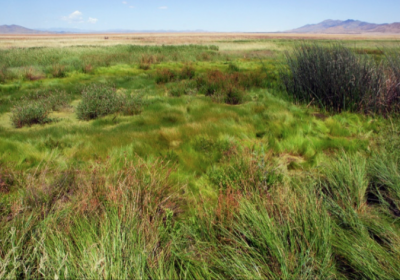Wetlands Action Plan - Arid-Land Spring Ciénegas Of New Mexico
 Arid-land springs are among the most rare and endangered ecosystems of the American Southwest. Arid-land spring ciénegas are wet meadows and marshes that are supported by 5 springs and groundwater seeps in arid and semi-arid regions, and generally occur at elevations below 2,000 m (6,562 ft). They are biologically and economically important as productive wetland habitats for plants and animals in an otherwise arid landscape. Many of the plant and animal species in arid-land spring ciénegas occur only in these rare habitats and nowhere else. Some arid-land spring ciénegas have been permanent hydrological features for millennia and are the last habitat remnants and refuges for their resident rare species. Arid-land spring ciénegas provide the only habitats for 10 New Mexico rare and endangered plants, of which 3 have been extirpated from the state. There are 23 threatened, endangered or sensitive animals that rely entirely or partially on arid-land spring ciénegas, including 11 vertebrates, 9 mollusks and 3 crustaceans.
Arid-land springs are among the most rare and endangered ecosystems of the American Southwest. Arid-land spring ciénegas are wet meadows and marshes that are supported by 5 springs and groundwater seeps in arid and semi-arid regions, and generally occur at elevations below 2,000 m (6,562 ft). They are biologically and economically important as productive wetland habitats for plants and animals in an otherwise arid landscape. Many of the plant and animal species in arid-land spring ciénegas occur only in these rare habitats and nowhere else. Some arid-land spring ciénegas have been permanent hydrological features for millennia and are the last habitat remnants and refuges for their resident rare species. Arid-land spring ciénegas provide the only habitats for 10 New Mexico rare and endangered plants, of which 3 have been extirpated from the state. There are 23 threatened, endangered or sensitive animals that rely entirely or partially on arid-land spring ciénegas, including 11 vertebrates, 9 mollusks and 3 crustaceans.
Arid-land spring ciénegas are rapidly vanishing across southwestern U.S. and northern Mexico. An initial 2015 inventory identified 50 arid-land spring ciénegas in New Mexico (Cole and Cole 2015). Only 26 of these were assessed as being functional or restorable with the remainder being no longer in existence or severely damaged and/or reduced in size. The New Mexico arid- land spring ciénegas inventory for this WAP identified an additional 119 arid-land spring ciénegas for a total of 169, which is still a small number for such a unique kind of wetland in an arid setting. These are scattered throughout the state, but are especially concentrated around the Roswell, Santa Rosa and La Ciénega artesian basins.
Most extant arid-land spring ciénegas are damaged from land and water use and continue to be threatened by impacts from aquifer capture and depletion, gully formation, agricultural use, impoundment excavations and dams, non-native plants and animals, and a warming and drying climate.

